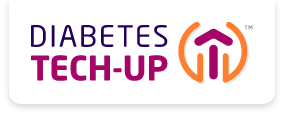Partnering with patients to unlock the potential of diabetes data
By Amy Hess-Fischl, MS, RDN, LDN, BC-ADM, CDCES
5 min read

Blood glucose levels. Time in range. Percent of time spent in hypoglycemia. Carbohydrate amounts. Insulin doses. Activity minutes. Treating people with diabetes involves gathering a lot of data and then spotting trends that can inform shared decision making and treatment plan adjustments.1
Some patients prefer to review their diabetes data with me before they make changes. Others look at their data and feel empowered to make decisions on their own. Either way, understanding the data can help them optimize their routine.1,2,3
Fortunately, there are some innovative data capture tools out there to help capture and synthesize diabetes data autonomously, including continuous glucose monitors (CGMs), insulin pumps, connected insulin pens and pen caps, and diabetes management apps to name a few.
But in order to get the most out of this tech and the data it collects, I recommend taking the time to do the following 4 things to help make people with diabetes aware of their options.

Some patients prefer to review their diabetes data with me before they make changes. Others look at their data and feel empowered to make decisions on their own. Either way, understanding the data can help them optimize their routine.1,2,3
Matching patients to tech that’s right for them
There’s no right digital health tool for everyone. Before I prescribe any diabetes technology, we have a conversation where I encourage the patient to open up about what they want, what they feel they can handle, and what they’re comfortable with.
I try not to make assumptions about people based on things like their age, education level, or experience with diabetes. I’ve seen senior citizens who’ve been completely comfortable reading a graph of their Ambulatory Glucose Profile (AGP), but I’ve also seen young working professionals who get stressed out at the mention of math. And I recognize that not everyone shares my enthusiasm for tech: while many of my patients are eager to get started looking at their continuous data stream, some prefer the familiarity of their tried-and-true methods.
I also try to get a sense of people’s financial situation and how it may affect someone’s decision about tech. Whenever possible, I try to give my patients guidance to help them balance what they want with what they can afford.
It’s important to me to base my recommendations on people’s values and priorities; to find out what they want, not tell them what they need. The upfront conversation helps me get a clear picture so we can move forward with a shared goal.

Explaining the features and answering questions
It’s normal for people to be hesitant about changes to their management plan and to have a lot of questions. When I am proposing they consider using a new piece of diabetes tech, I like to start by showing them how it works and how having certain data could help them manage their diabetes day-to-day.
And of course, I believe training and ongoing support are essential when patients are trying a device that’s new to them. I give them hands-on demonstrations (or if we’re on a video call, I make sure they have the device in hand on their end) and schedule time for follow-up during subsequent appointments.
This usually opens the door to a lot of important questions, especially if I am recommending a wearable device. Some of the most common questions I get are:
- Is it comfortable?
- How big is it?
- Can I customize the alarms?
- What kind of adhesive does it use?
- Do I have to wear it 24/7?
- Can I wear it while working out?
- Will it stay on while showering or swimming?
While they may not like all the answers to these questions, they appreciate knowing generally what to expect vs having to fear the unknown. Also, it’s important to discuss that once any tech is started, we have options to problem solve if difficult situations arise.
For example, I had a patient who loved using her CGM but had trouble with skin irritation. She didn’t tell me at first because she didn’t want to have to go back to finger sticks. When I asked her if there was anything she needed my help with, she reluctantly told me about the problem. She was relieved when I showed her how to insert the patch through a hydrocolloid pad to prevent the dermatitis. But if we hadn’t talked about it, she might have thought the rash was normal and continued to suffer in silence.
Taking it step-by-step3,4

If a person with diabetes is still hesitant about a device I am recommending, I start small to help build their confidence. For example, I suggest that they start manually tracking their glucose data via a diabetes management app before gradually working their way up to tracking their glucose automatically via a CGM. Comparing BGM to CGM—which is more practical: to conduct multiple finger sticks per day, or to wear a CGM? I put the options out there and let them decide.
Once they’re comfortable, I ask if they’d be willing to try a CGM on a trial run for two weeks before their next appointment so we can look at the data together and find areas that could be changed.
For insulin-using patients, I may suggest starting with a connected insulin pen or pen cap before moving onto an insulin pump. I’ve worked with many people who have been able to handle incremental diabetes tech adoption more readily than big, sweeping changes.
But… go with the person in front of you. If they are ready to jump right in, let them. Just help them prepare and understand that it may take time and patience to get comfortable.
Helping people with diabetes share and act on the data1,5

When someone is ready to give a piece of tech a try, I always make sure they know how to share their data with me and other members of their care team, if they choose. Most diabetes tech companies provide education and support for how to use the device and their data. I always recommend they use these resources to help them feel more educated and confident.
I encourage my patients to upload and review their data regularly. Whether they look at it on their own or wait to go over it with me, this allows them to see patterns and prepare to talk with me about what treatment or lifestyle changes they feel they could make. It also gives people the chance to self-correct habits they never knew they had.
One of the best parts of getting all this data is being able to help people with diabetes understand the relationship between insulin dosing, eating patterns, activity, stress, and blood glucose levels—and, for people who are comfortable with it, empowering them to use that information to make self-management decisions.
Tech-up Follow-ups
- Make a list of patients you think might benefit from using a data capture tool, such as a CGM, connected insulin pen/pen cap, insulin pump, etc.
- Talk with these patients at their next appointment about ways a data capture tool may help empower them to make self-management decisions. (And always be open to the possibility that they may ask you about a tool after hearing about it elsewhere.)
- Work with the technology’s vendor or your staff to give the patient a demo of how the tool works and explain how it may help.

Amy Hess-Fischl, MS, RDN, LDN, BC-ADM, CDCES
Chicago, Illinois
Amy is a diabetes care and education specialist and registered dietitian who sees type 1 and type 2 diabetes patients daily. She oversees their education recognition program and coordinates the Teen and Adolescent Diabetes Transition Program at University of Chicago’s Kovler Diabetes Center. She received the American Diabetes Association’s Outstanding Educator of the Year award in 2022.
Amy Hess-Fischl received a fee from Novo Nordisk for her participation.
–— Recommended for you –—
References
- Arbiter B, Look H, McComb L, Snider C. Why Download Data: The Benefits and Challenges of More Diabetes Data. Diabetes Spectr. 2019;32(3):221-225. doi:10.2337/ds18-0099
- Sy SL, Munshi MM, Toschi E. Can smart pens help improve diabetes management? Diabetes Metab J. 2021;45(6):813-839. doi:10.4093/dmj.2021.0177
- Swanson V, Maltinsky W. Motivational and behaviour change approaches for improving diabetes management. Practical Diabetes. 2019; 36(4):121-125.
- Graffigna G, Barello S, Libreri C, Bosio CA. How to engage type-2 diabetic patients in their own health management: implications for clinical practice. BMC Public Health. 2014, 14:648. http://www.biomedcentral.com/1471-2458/14/648
- Espinoza JC, Chin SW, Shah P, Tut M, Raymond JK. Proposing a Practical, Simplified Framework for Implementing Integrated Diabetes Data and Technology Solutions. Front Clin Diabetes Healthc. 2022;3:867284. Published 2022 May 11. doi:10.3389/fcdhc.2022.867284
The Diabetes Tech-upTM Podcast
Join our expert cohosts for a series of discussions about how they’re integrating diabetes tech with patient-centered care to help optimize diabetes management.
The Mission of Diabetes Tech-upTM
Diabetes Tech-upTM is sponsored by Novo Nordisk, a global leader in diabetes. We believe that adoption of innovative technologies can help appropriate patients better manage diabetes. Our goal is to provide information to help health care professionals on the front line of diabetes care strengthen their understanding of diabetes technologies and implement them where they can have the greatest impact.




Share: